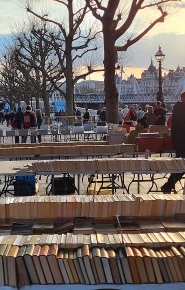Adam Yamey's Blog: YAMEY, page 57
March 25, 2024
Taking the plunge in a cold bath at Kenwood in north London
I HAVE VISITED Kenwood House and its grounds innumerable times since my childhood, but it was only today (the 21st of March 2024) that I have been able to enter a part of it that has always been locked up whenever I have been there before. I am referring to a small building known as “The Bath House”. It is close to the courtyard where there are tables and chairs for visitors to use while enjoying refreshments.
A short staircase leads down to the door of the Bath House, which was probably already in existence when the Mansfields bought Kenwood and its grand house in 1754. The interior of the small edifice contains a circular pool. The wall around the marble-lined pool has several alcoves, and the concave ceiling is a plastered circular dome. What can be seen today is that is a faithful reconstruction of what had been there originally.
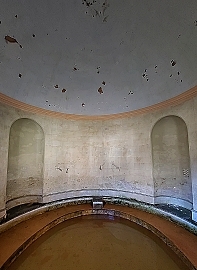
The pool used to be filled with cold water from one of the many iron-rich chalybeate springs in the area. In the 18th century, the chalybeate springs in nearby Hampstead were almost as famous and as much visited as those in Royal Tunbridge Wells (in Kent). The inhabitants of Kenwood House used to plunge themselves into the cold water because it was considered to be beneficial for health reasons in the 18th century.
It was only the select few who had the luxury of taking the plunge in such an elegant pool as can be seen in Kenwood. The other locals living in Hampstead had to make do with bathing in the many ponds that can still be seen dotted around Hampstead Heath. Within Kenwood House today, we saw a painting by John Constable (1776-1837) that depicts one of these ponds being used by bathers. For many years, the artist lived in Hampstead.
Small though it is, it was exciting to see within the Bath House at long last. For many decades, I have wondered what was within it, and now my curiosity has been satisfied.
March 24, 2024
Books and trees
March 23, 2024
The Virgin Queen visited here to watch the hunt in Epping Forest
IT HAS BEEN STANDING for many centuries, but until we saw something about the place in a recent (March 2024) issue of the free Metro newspaper, we did not know it existed. The place is located in Epping Forest on Rangers Road, which runs eastwards from Chingford (on the edge of northeast London). I am referring to a well-preserved, whitewashed, half-timbered Tudor building, which was constructed in 1543 for King Henry VIII, and renovated by his daughter Queen Elizabeth I in 1589.
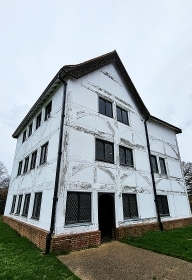
This edifice, which is 481 years old, is aptly known as ‘Queen Elizabeth’s Hunting Lodge’, and is open to the public to explore. It is a timber-framed three-storey ‘standing’. That is to say that it was constructed to be used as a place from which the hunt could be observed. And Epping Forest, where it stands, was, from the 12th century until the 19th century a Royal Forest, where only the monarch had the right to hunt deer. Although now fully glazed, originally the window apertures on the two upper floors were without glass. Visitors to the lodge would have been able to watch the hunt and, maybe also, shoot animals from these raised vantage points.
Throughout the building, one can see unpainted oak beams – supporting the floors, the walls, the ceilings, and the roof. The ground floor consists of an entrance hall and a larger room (with a fireplace), which served as a kitchen. A wooden staircase leads to the upper floors. It is wrapped around a square hollow newel, which supports the stair treads. There is a glass pyramid (not Tudor) above this space, which allows visitors to see the original lath and plaster work that makes up the newel.
Much of the first floor is occupied by a large hall with windows overlooking the forest. The second floor is similar, but it has a fine hammer-beam ceiling. Another such ceiling is high above the top of the staircase.
During the reign of Queen Victoria, the first floor of the lodge was divided into small bedrooms by partitions, which have long since been removed. It was then used as accommodation by the bailiff of the local lord of the manor. The Watkins family were residents for a period. It was Mrs Harriet Watkins, who used the Lodge and its garden for providing refreshments until 1897, when she took over the adjacent barn – now known as Butler’s Retreat – for the provision of teas. Writing about the lodge in 1876, James Thorne noted:
“The open space in front of the lodge has always been a favourite resort of the East-end holiday folk, for whom ‘tea and refreshments’ are provided at the lodge. On a fine summer’s day, on Monday especially, numerous picnic and ‘van’ parties may be seen, with swings improvised between the oaks, and gipsies with their donkeys in attendance.”
Regarding the suitability of the position of the lodge, he wrote:
“The ground, sloping gently from the lodge on all sides, used to be everywhere unenclosed, the tract beyond being open forest, with some famous unlopped trees, but chiefly, as in other parts of Epping Forest, of pollard oak.”
Today, standing on the second floor, or even on the first, one gets a good panoramic view of the surrounding land.
Queen Elizabeth’s Hunting Lodge is not as grand as some other surviving Tudor buildings (e.g., Hatfield House), but it has been well looked after and it is a remarkable survivor, which is well worth a visit. But before you go, please check the current opening tomes if you wish to explore its interesting interior.
March 22, 2024
Gas holders at London’s Kings Cross now reused for householders
The remains of former gas storage units (gasometers) have been spruced up and repurposed as blocks of flats (near King’s Cross Station). Where the telescopic, cylindrical gas holders used to be, there are now cylindrical apartment blocks.
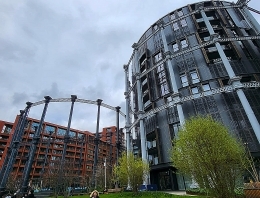
A friend pointed out:
” I marvel at the ingenuity and question how you’d furnish such impractical circular geometry that would probably require bespoke furniture. But frankly if you can afford to buy/rent one, you should be able to foot that expense!”
She has made some good points about these buildings.
March 21, 2024
Bacon, the Bard, and Butler’s Retreat in Epping Forest
VISITORS TO QUEEN Elizabeth’s Hunting Lodge in Epping Forest can obtain food and drink at the nearby Butler’s Retreat. I will describe the Hunting Lodge in another essay, and will now concentrate on the small weatherboard clad building called Butler’s Retreat, and something that stands close to it. The Retreat is housed in an edifice that was originally built as a barn in about 1859. The Conservators of Epping Forest converted it into a retreat – a refreshment place – in about 1878.
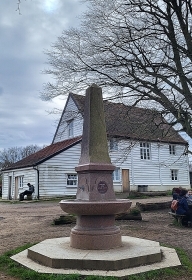
The Retreats in Epping Forest were originally refreshment stalls set up by the Temperance movement to serve non-alcoholic drinks to the many trippers who came to enjoy the forest. Butler’s Retreat is one of the last surviving Victorian retreats in the forest. Its name derives from that of:
“John Butler who took over the lease of the barn on 1st January 1891 having previously operated a kiosk in the forest.” (www.chingfordhistory.org.uk/butlers-retreat-and-drinking-fountain)
His wife, Hannah, took over the refreshment business in 1903, and the Butler family ran it until 1971. After closing in 2009, the building was refurbished by the City of London Corporation (which maintains the forest) and re-opened as a cafe in 2012. The café no longer confines itself to non-alcoholic beverages. In addition to drinks, it serves a range of snacks and light meals. These can be eaten at tables outside the building or within its attractive dining areas in which supporting timber beams can be seen. They support the roof above the first-floor dining room.
Forty-five feet away from the northeast corner of Butler’s Retreat, there is an intact, but disused, pink granite drinking fountain, which was restored in 2011. Constructed in 1899, it was donated by Sir Edwin Durning-Lawrence, Bart, MP (1837-1914). After studying law at London’s University College, he qualified as a barrister at Middle Temple in 1867. During his working life he was both a Justice of the Peace and served as a Member of Parliament for Truro (from 1895 to 1906). Two of his brothers served as Lord Mayors of London.
Sir Edwin was a prolific author. He is best known for his writing in support of the idea that the plays attributed to William Shakespeare (1564-1616) – the Bard – were not written by him but by Francis Bacon (1561-1626). I am in no position to assess Sir Edwin’s arguments, but I believe that most modern scholars tend to believe that it was not Bacon but Shakespeare who wrote the plays.
Apart from providing the fountain near Butler’s Retreat, Sir Edwin donated his extensive library to the University of London. Also, some of the money he left to the university was used to endow a professorial chair in the History of Art department at his alma mater – University College London.
The drinking fountain at Butler’s Retreat is nothing too out of the ordinary to look at, but I am pleased that I did examine it closely to see what was inscribed on it, and noticed the name of Sir Edwin. It is interesting that this drinking fountain, which was donated by someone who doubted Shakespeare’s authorship, should be situated only a few yards away from a building that was standing during the Bard’s (and Bacon’s) lifetime – Queen Elizabeth’s Hunting Lodge.
March 20, 2024
A ghost sign on a building near Kings Cross railway station
Definition: GHOST SIGNS are ” … fading advertisements once painted by hand onto buildings …”
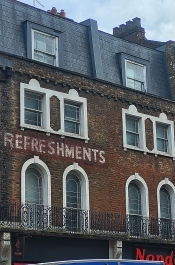
The photograph above is a simple example. Now a branch of Nando’s, this place in York Way (near Kings Cross station), which bears a ghost sign. It used to house a place where other refreshments were available long before Nando’s company was established.
March 19, 2024
THY HAND, GREAT ANARCH BY NIRAD CHAUDHURI
HAVING BEEN BEFRIENDED by the author’s son Prithvi, and having seen some of his father’s belongings stored in the Calcutta Club (in Kolkata), I finally got around to reading a book that I bought almost 30 years ago. The 960-page volume by Prithvi’s father, Nirad C Chaudhuri (1897-1999), is called “Thy Hand, Great Anarch”, and was first published in1987. The title comes from a couplet in a poem by Alexander Pope (1688-1744):
“Thy hand, great Anarch! lets the curtain fall;
And universal Darkness buries All.”
This pessimism well summarises what Chaudhuri has written in his enormous tome.
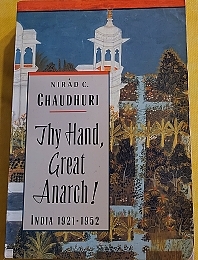
The book is the second part of Chaudhuri’s autobiography. It covers the period from 1921 to 1952 – the years leading up to the end of British rule in India and the first few years after the country gained its independence. Chaudhuri was a keen observer of what was going on in India during this period. Without pulling any punches, he gives his often-critical opinions of what was going on in the country, and never fails to point out what he felt was being done wrong both by the British and also by the Indians fighting for the end of British rule. Although he wrote this book long after 1952, he quotes from things he wrote during the period he described. He did this, I believe, to prove to the reader that his frequently idiosyncratic opinions were not as a result of looking back with hindsight, but were what he thought at the time.
One of Nirad’s chief criticisms of the various different freedom fighters was that they all expressed their dislike of British rule but, according to him, none of them proposed plans for how India was to be ruled if or when independence was achieved. I have read several books about the history of India’s fight for freedom, and most of them portray leaders such as Gandhi, Nehru, Vallabhai Patel, and Subhash Chandra Bose as heroic figures. This was not how Nirad portrayed any of them. Having been the personal secretary of Bose’s brother Sarat Bose, Nirad was in a good position to observe many political events at close hand. As for Gandhi, he wrote (giving his reasons):
“To take the question of his contribution to Indian independence first. It is a blatant falsehood to say that he or his movements brought it about, whatever their moral effect.”
This was not an opinion I had come across before in histories of the struggle for India’s independence. It is his highly individual and original views that help to make his book so engaging. He writes very scornfully of Subhash Chandra Bose’s politics and his cooperation with the British Empire’s enemies during WW2. As for Jinnah – the ‘father’ of Pakistan – he showed less disdain, writing:
“I must set down at this point that Jinnah is the only man who came out with success and honour from the ignoble end of the British Empire in India.”
Unlike members of the Indian National Congress and their opponents – the British Government, Jinnah:
“… never made a secret of what he wanted, never prevaricated, never compromised, and yet succeeded in inflicting an unmitigated defeat on both the British Government and the Indian National Congress.”
Although I got the feeling that Chaudhuri admired the British and believed that Indians would fare better by being part of the British Empire than they would in an India ruled by Indians, his book is by no means short of criticism of the British as colonists, during the last years of empire, and after India became independent. Figures such as Attlee and Mountbatten get little or no praise from Nirad. At the beginning of a chapter called “Mount Batten Piled on Mount Attlee”, he wrote:
“As if Attlee single-handed was not enough to complete the work of demolition begun by the more cunning mediocrity. Baldwin, he piled on himself Lord Mountbatten to add greater work to his policy, which brought endless misfortunes to the Indian people.”
As the book’s title suggests, the text contains Nirad’s views on the anarchy he perceived developing as India approached independence, and then after having achieved it. It is not surprising, given what he wrote and thought about the country of his birth that Nirad chose to move to England (in about 1982) and lived there until he died. Many readers might be surprised or even horrified by what the author wrote, but he takes care to make whatever he thought sound reasonable to his readers. There are parts of the book which I found hard going – difficult to comprehend, but I ploughed on regardless, and was pleased that I did.
March 18, 2024
White roses
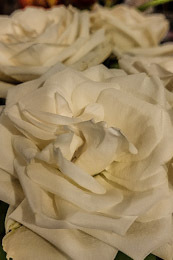
Layers of petals
Overlapping each other
Quite a pleasing sight
March 17, 2024
DON’T EXPECT TOO MUCH FROM THE END OF THE WORLD AT A CINEMA NEAR LONDON’S HOLBORN
THE GARDEN CINEMA is in Parker Street, which is near both Holborn Underground station and Covent Garden. This gem of a place opened in 2022. Housed in the building which formerly contained the offices of businessman Michael Chambers, who founded Chambers and Partners in 1989, a research company for law firms around the world, it was the realization of Mr Chambers’s dream to create a cinema for film enthusiasts such as he is.
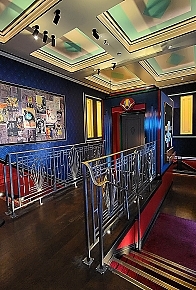
The ticket office is on the ground floor. Stairs and lifts lead to the basement, where the bar, various small seating areas – some quite discrete, and the two auditoriums are located. The premises are designed and decorated with many Art Deco features and a good selection of sculptures and prints. The darkly coloured wallpaper (with nods to the William Morris style) and subdued lighting give the place a cosy, intimate night club atmosphere. The bar is reasonably priced. The staff are friendly and helpful. This is a cinema complex quite unlike any other I have visited in London – it is both stylish and intimate.
We watched a Romanian film made in 2023: “Do Not Expect Too Much from the End of the World”. Before I discuss this excellent movie, let me tell you one more unusual thing about The Garden Cinema. There were no advertisements (commercials) prior to showing the main film – only several trailers of forthcoming shows in the cinema. This is quite different from other ‘independent’ cinemas, in which the feature film is always preceded by ads including one for the car company (currently Kia), which supports independent cinemas.
The Romanian film, which runs for almost three hours, is a ‘whacky’ and gritty black comedy with serious comments about life in post-Communist Romania. The brilliantly acted film blends skilfully ‘doctored’ flashbacks to life in Ceausescu’s Romania with scenes in Romania since the war in Ukraine commenced. One of the many things that this highly entertaining film emphasises is how the difficult, regimented, but relatively simple life under the dictatorship contrasts with the hectic, corrupt, and very hard life in capitalist Romania. Nothing was easy during Ceausescu’s ‘reign’, but after it ended, nothing has made life any easier. The film made me think that the tyranny of the dictator has been replaced by the tyranny of corruption and exploitation of cheap labour by countries outside Romania. Another thing that I felt was that the film showed how when the shackles of a highly oppressive regime were released following the death of the dictator, Romanian society seems to have gone crazy. Whether this is an exaggeration by the film makers or truly reflects contemporary life in Romania, I do not know. All I can say is that the 163 minutes of the film sped past remarkably quickly because I found it so highly enjoyable and engaging.
Even if I had not enjoyed the film so much, I would have thought highly of the Garden Cinema – a place I hope to visit many more times in the future.
March 16, 2024
AN OLD THOROUGHFARE NEAR LONDON’S WATERLOO RAILWAY STATION
WE ARE KEEN on many of the plays put on at the Young Vic Theatre on The Cut near Waterloo Station. Last night (the 11th of March 2024), after seeing a superb performance of a weird but enjoyable play (about a painting by an infamous dictator) called “Nachland”, we walked along The Cut and then further west along a street called Lower Marsh. Sometimes. we return from the theatre via Lower Marsh, and I have often wondered about its name.
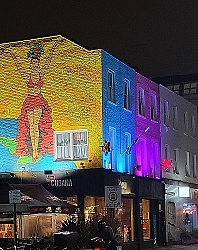
About 344 yards in length, Lower Marsh runs southwest from near the Old Vic theatre on Waterloo Road to Westminster Bridge Road. Until the 19th century, much of the northern tip of the old Parish of Lambeth, where Waterloo Station and the South Bank are now located, was marshland. A settlement called Lambeth Marsh (after which Lower Marsh was named) was first recorded on a document in 1377. This settlement ran along a raised road that some believe dated back to Roman Times. The marshland was drained in the 18th century, and by the 19th century isolated individual houses were being built in Lambeth Marsh. In 1848, after the opening of Waterloo railway station, the area known as Lambeth Marsh became known as it is now – as Waterloo. Lower Marsh and its neighbour The Cut formed the commercial area of the district.
There has been a market in Lower Marsh since the early 19th century. As I have only ever walked along Lower Marsh in the late evening, I have never seen the market in action. The street, which was already marked on a map drawn in 1690, linked two bridges (Waterloo and Blackfriars) constructed in the mid-18th century, and ran past:
“Leisure activities, including pleasure gardens, circuses, theatres which characterised the south bank in the late eighteenth and early nineteenth centuries [and] were present in and around Lower Marsh.” (www.lowermarshmarket.co.uk/).
During the 19th century
:“The building of Waterloo Station in 1848 and its subsequent expansion cut the street off from the riverside, creating a number of yards and cul de sacs from former streets. In the twentieth century war damage, and subsequent housing redevelopment significantly changed the historic street patterns, confining the street market to Lower Marsh.”
Until quite recently (in the 21st century) Lower Marsh and its surroundings would have been described as somewhat ‘run down’. But of late, the area has undergone ‘gentrification’ and become quite a ‘trendy locale. As the Lower Marsh Market website related:
“The current buildings on Lower Marsh Street represent many different phases of development and several styles. Amongst the diverse buildings are some interesting examples of early nineteenth century vernacular architecture, continuing the Georgian vernacular patterns and layouts of the eighteenth century. Good examples of shop-fronts from different eras are present on the street and courts and alleyways and some original paving can still be seen on streets off to the sides. This variety gives the area great character, enhanced by the market.”
In 2015 and 2016, the market took first place in the shopping category of The Time Out Love London Awards. Next time we go to a matinée at either The Young Vic or The Old Vic, we will leave early enough to take a look at the market.

